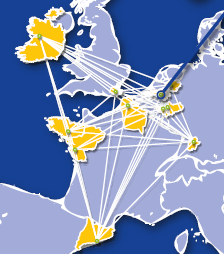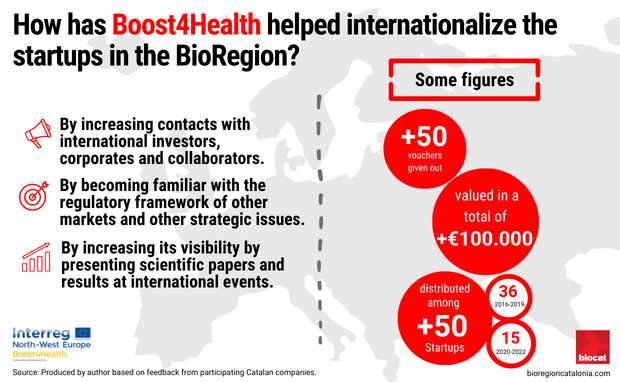Measuring the impact of the projects: the case of Boost4Health (I)
Only a few months from completion, Boost4Health has helped over 50 startups from the BioRegion in their internationalization. Beyond measuring the number of companies or how they access new markets thanks to the grants received, this post goes a step further and provides an overview of the possible impact of the positive effect on the health of people and patients.

“The dots can only be connected backwards, not forwards”. These are the words of Josep Lladós, director of the Computer Vision Center, when he collected the National Research Award for Public-Private Partnership in R&D with Intel Intelligent Systems Lab on June 7th.
In fact, a chain of events and actions must be described when speaking of impact, often connecting the dots backwards and seeking their causality, attribution or contribution to the end result.1 How the Boost4Health (or B4H) project, started by Biocat in 2016 along with a European consortium formed by other life and health science clusters from Europe, has contributed towards the internationalization of over 50 SMEs from the BioRegio around Europe.
The approach to the project, which ends this summer, is simple and extremely practical: providing direct grants to companies to hire experts and services in order to progress in their TRL and open up new markets for them and for the service providers they hire. Any exchange is made via a platform where SMEs and service providers register and become eligible.

The outputs of the project would be the exchange platform, the deliverables, the number of companies and providers, the vouchers given out, the market and service analyses, the communication pieces. Outcomes would result from these, such as the agreements signed between SMEs and providers, the activities of these companies in new markets, the activities developed, etc.
But what is the value of all this? What difference does this project make? What does is transform... in short, what is the impact? This question is used to broach a subject of assessing the impact of the research (or the projects).
Map of European life and health science clusters taking part in Boost4Health. Source: Boost4Health.
Catalan health startups size up international markets
Over the six years of the Biocat program, almost all the vouchers available have been given out: more than 50 grants and over 100,000 euros. They all found out about the grants through Biocat, primarily through its digital channels –website, social media, and newsletter-, and we wanted to ask them their opinion of the project that has helped them. The response was encouraging.
For some, like Health Circuit, attending international events has enables them to make contact with international investors and organizations that they were previously not connected to. “It has been very useful to contact key players in the international ecosystem”, said Isaac Cano, CEO and founder.
Others have been able to expand their knowledge of strategic issues, such as international regulation, enabling them to launch their product in other markets. “We have found out about the requirements we must meet as a medical device in terms of regulatory affairs, which will obviously have an impact on our internationalization, at least in Europe (EC) and the United States (FDA)”, explained Daniel Esteban, CEO of ViReInstruments.
Others have increased their visibility in international markets by presenting papers and clinical results at events, such as MOOWOT, which was able to present a poster on the results of our study at the IHF World Hospital Congress 2021.

Beyond crossing borders
Although Biocat encourages an approach to internationalization by companies, we also like to think that our activity saves lives or at least makes them better. And we like to think that we help make this happen more quickly and effectively.
This is why we have calculated the value of the project, simplifying it by focusing solely on the second phase of the project -capitalization stage- , in which we provided grants to a total of 15 startups from the BioRegion in all subsectors. The beneficiary companies were Breaz, Bsure, Chasing Science, eHealthAI, Flomics, Gate2Brain, Health Circuit, Loop-Dx, MOOWOT, Nano1Health, Nen, Ninevah, Nixi for Children, Oniria Therapeutics and ViReInstruments. The clinical areas of the companies are oncology, the central nervous system, infectious diseases, respiratory diseases, the digestive system, pediatrics, and the digitization of health services, among others. The market size for these companies in Europe and the United States is 2,500 million people.
Through B4H, we have provided support to encourage the international growth and positioning of companies that, as a whole, have the potential to help improve the lives of a potential market of 2.5 billion people (1/3 of the world population). We will only find out in the future, however, whether these outcomes will make any difference or whether they will have an impact, connecting the dots backward and analyzing the causality, contribution or attribution of B4H to their success. And this analysis applies to all the projects in general, and the European ones in particular. We will reveal how and why in a future post.
References
1. https://www.sciencedirect.com/science/article/abs/pii/S0048733321000044
https://www.theinternationalschoolonria.com/uploads/resources/melbourne_school_2016/16_11_Block_5_Effective_communication_strategy.pdf
https://tiess.ca/en/13-proving-impact-causality-attribution-and-contribution/


